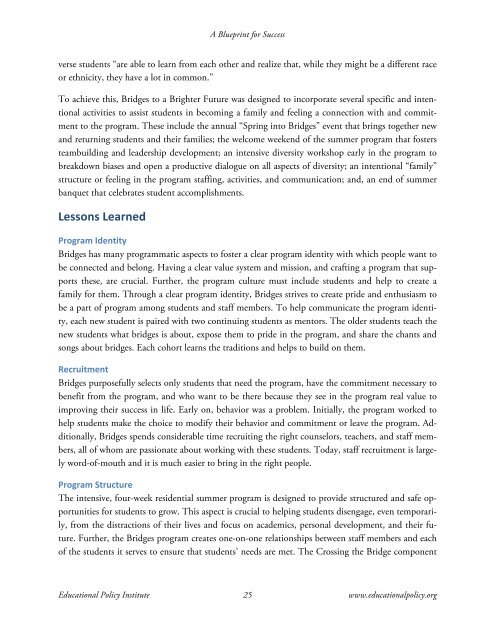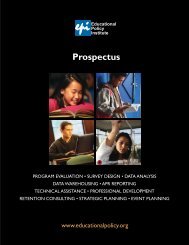A BluePrint for Success: Case Studies of Successful - Educational ...
A BluePrint for Success: Case Studies of Successful - Educational ...
A BluePrint for Success: Case Studies of Successful - Educational ...
You also want an ePaper? Increase the reach of your titles
YUMPU automatically turns print PDFs into web optimized ePapers that Google loves.
A Blueprint <strong>for</strong> <strong>Success</strong><br />
verse students “are able to learn from each other and realize that, while they might be a different race<br />
or ethnicity, they have a lot in common.”<br />
To achieve this, Bridges to a Brighter Future was designed to incorporate several specific and intentional<br />
activities to assist students in becoming a family and feeling a connection with and commitment<br />
to the program. These include the annual “Spring into Bridges” event that brings together new<br />
and returning students and their families; the welcome weekend <strong>of</strong> the summer program that fosters<br />
teambuilding and leadership development; an intensive diversity workshop early in the program to<br />
breakdown biases and open a productive dialogue on all aspects <strong>of</strong> diversity; an intentional “family”<br />
structure or feeling in the program staffing, activities, and communication; and, an end <strong>of</strong> summer<br />
banquet that celebrates student accomplishments.<br />
Lessons Learned<br />
Program Identity<br />
Bridges has many programmatic aspects to foster a clear program identity with which people want to<br />
be connected and belong. Having a clear value system and mission, and crafting a program that supports<br />
these, are crucial. Further, the program culture must include students and help to create a<br />
family <strong>for</strong> them. Through a clear program identity, Bridges strives to create pride and enthusiasm to<br />
be a part <strong>of</strong> program among students and staff members. To help communicate the program identity,<br />
each new student is paired with two continuing students as mentors. The older students teach the<br />
new students what bridges is about, expose them to pride in the program, and share the chants and<br />
songs about bridges. Each cohort learns the traditions and helps to build on them.<br />
Recruitment<br />
Bridges purposefully selects only students that need the program, have the commitment necessary to<br />
benefit from the program, and who want to be there because they see in the program real value to<br />
improving their success in life. Early on, behavior was a problem. Initially, the program worked to<br />
help students make the choice to modify their behavior and commitment or leave the program. Additionally,<br />
Bridges spends considerable time recruiting the right counselors, teachers, and staff members,<br />
all <strong>of</strong> whom are passionate about working with these students. Today, staff recruitment is largely<br />
word-<strong>of</strong>-mouth and it is much easier to bring in the right people.<br />
Program Structure<br />
The intensive, four-week residential summer program is designed to provide structured and safe opportunities<br />
<strong>for</strong> students to grow. This aspect is crucial to helping students disengage, even temporarily,<br />
from the distractions <strong>of</strong> their lives and focus on academics, personal development, and their future.<br />
Further, the Bridges program creates one-on-one relationships between staff members and each<br />
<strong>of</strong> the students it serves to ensure that students’ needs are met. The Crossing the Bridge component<br />
<strong>Educational</strong> Policy Institute 25 www.educationalpolicy.org




